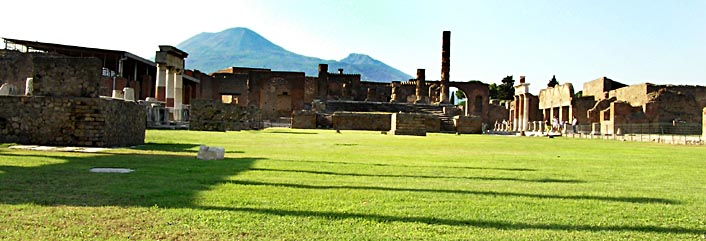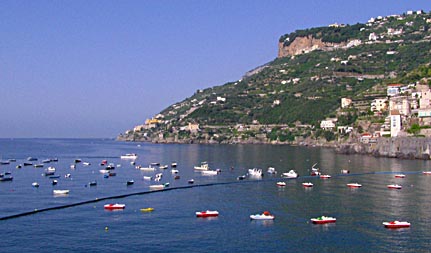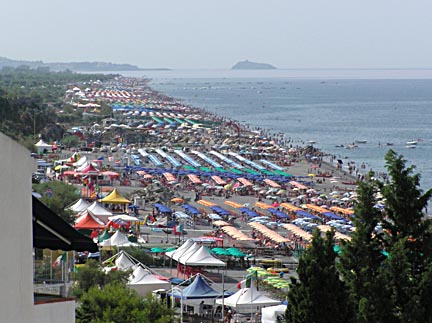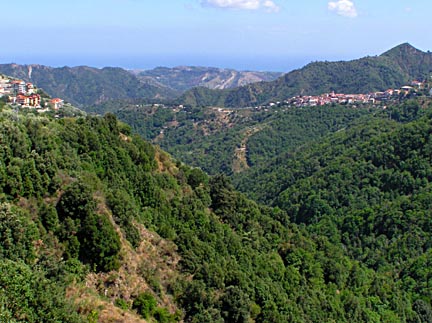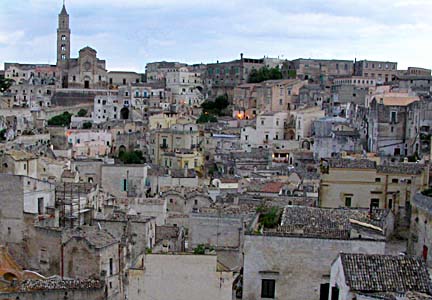|
We started our tour of southern Italy in the summer of 2005, in the midst of the summer heat and tourist season. It was not the best timing on our part, but it was when we were there, so we thought we would make the most of it. Once we got south of Rome, we seemed to have lost the oppressive humidity that was so pervasive in the north. The drier heat at least made it more tolerable. For our purposes only, we have defined Southern Italy as the portion of Italy south of Rome.
Our first stop was Pompeii, site of the devastating eruption from Mt. Vesuvius. The ruins are quite extensive and most structures are still intact, albeit most without roofs. There are several body-casts throughout, giving a sense of the horror that was exacted on these people. The stone streets still bear the marks of the carts used daily to transport goods to market and the amphitheater sits strangely quiet, as if waiting for the throngs to arrive. It is truly a ghost town, with many stories to tell. Above is the Forum, with a view of Mt. Vesuvius in the background. Click here for a slide show of Pompeii.
We skirted Naples as we wanted to avoid the big city with all the traffic, and headed directly to the Amalfi coast where we enjoyed stunning views of the hillside towns and sparkling coast (photo below of Maiori).
|
The traffic here was fairly bad, but luckily we hit it in the early morning, before the worst of it. Many of the hairpin turns are so tight you must wait if a bus or large truck is coming the other way - so they honk their horn as they approach the curve, expecting that others will heed their warning. The traffic worsens as delivery trucks stop to off-load goods or people park in the already narrow street to run in for their morning cup of coffee. There is a cadre of young people in uniform with traffic signs, hoping to keep the traffic moving. Sometimes they are successful. But without them, it would probably be even worse.
|
|
|
This area of the coast continues to Solerno where the terrain eases and a wider road is built. Click here for a slide show of the Amalfi Coast.
|
|
Heading south from Salerno, the west coast is dotted with small towns and picturesque beaches. Some are ready for the beach-goers and have every bit of sand covered with multicolored umbrellas and chaise-lounges, all in formation like a marching corps (photo left). Because of the heat, we choose to head inland, hoping to catch some coolness from the nearby mountains. The mountains are indeed cooler and there is usually some shade to be found at the side of the road as we take a break or stop for lunch. Click here for more photos of the West Coast.
|
|
|
We also took a brief visit to Paestum, site of the Greek city of Poseidonia, founded around 600 BC. Here is a vast complex of ruins, including many temples and the Agora. Several large temples are quite well preserved, namely the Temple of Hera and the Temple of Neptune (photo at right).
As we traveled south, we were surprised at how mountainous Italy is (guess we didn’t study our world geography very well). The center of the Italian peninsula is mountainous, all the way to the southern tip. For us, this was great as it allowed us to escape the coastal heat and crowds whenever we wanted. In the mountains it was cool and quiet and the campgrounds were empty. What a delight!
|
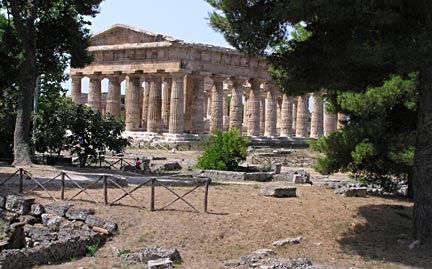
|
|
When we got to the southwestern coast, we jumped a ferry to Sicily (see separate page), then returned to Italy to continue our journey around the southeastern coast as we headed north. The coast at the very southern tip consists of rock cliffs that drop to the sea, with a narrow rock shelf for a “beach.” Swimming here was a delight, although getting in and out of the water was a bit of a challenge.
|
|
As we headed north, the terrain along the coast flattened, forming quite a few nice beaches. The traffic in the beach towns was pretty bad, so after a few hours, we once again headed into the mountains, this time into the Sila Piccola. Here, the trees were thick and the roads were narrow and winding. Overall, we probably didn’t make much better time than crawling through the coast towns, but it certainly was cooler and more picturesque. Small villages clung to the hillsides, seemingly alone in the woods. This is not a place where you can commute anywhere else for work, and we wonder what the future holds for these small communities (photo above, left).
|
|
We came out of the Sila into a long valley to the west where the Autostrada runs north and south (it is free along this stretch to the southern tip of Italy) and rode it north to the Parco Nationale del Pollino where we turned east to go back to the coast. Here the coast highway was a bit raised from the sea, providing us gorgeous views of the turquoise blue Ionian Sea.
|
Matera was our next stop and was quite a revelation. We had read about the Sassi area, but nothing we read had prepared us for the sight (photo, right). An entire gorge (actually, 2 gorges) have been transformed into a city of small houses where the poor lived. Centuries ago, people began living in the natural limestone caves that lined the gorge. Then they began carving out specific living spaces and cisterns for water. Over time, buildings were added onto, first using loose rocks, then later using blocks quarried out of the limestone. The result is a labyrinth of structures with stairs and paths leading to, in and around the structures. This was home to thousands of people and much of the area had no electricity, running water or sewer systems until well after WWII.
|
|
|
Now, many of the Sassi homes are being remodeled into homes and hotels, while the character of the area is being retained. Thanks to a chance meeting with fellow motorcyclists earlier in the month, we learned about a hotel in the Sassi and stayed there. Areas of the hotel are carved into the rock, including an old cistern. The other areas are original Sassi, but had been made from the blocks of limestone quarried nearby. Finding the hotel was an interesting process as there are so many levels and no path is straight. Verna was happy to have taken the GPS on her venture to find the hotel from where we parked, knowing she could at least find her way back! Click here for a slide show of the Sassi area.
From here, we headed to Bari to catch a ferry to Greece, but will be back to complete our tour in a couple of months. See you then!
|

